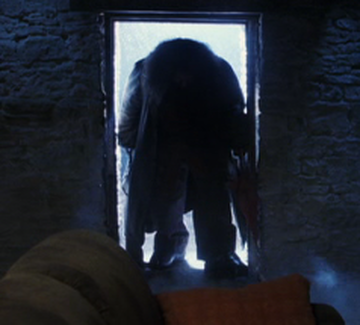
They're actually sweethearts. Usually, the gentle giant is the heart of whatever ragtag crew they adopt. Sweet and loving and sometimes not terribly smart, they usually have a childlike sense of wonder and faith and are loyal to the death to their friends. They also often have a connection to nature and a deep desire for peace. The trope is so prevalent that it's surprising when a contemporary character played as a looming, menacing thug doesn't turn out to be a sweet little kid on the inside.
This is a reversal of a common-sense social judgment (hey, that guy looks like my nightmares, better keep away just to be safe) that first seems to have occurred with Mary Shelley's Frankenstein. The monster in Frankenstein proves himself to be capable of reason and mercy, and takes care of things that are weaker than him, in contrast to Dr. Frankenstein himself, who becomes more monstrous and maddened by fear as the story goes on. This reversal (Hey! This guy looks bad, but get this, he's actually good!) must have at one point been a refreshing concept. Now, it's a trope of its own.However, before Shelley's time, the usual perception of a giant was as a brutal, filthy, stupid creature. While that trope itself is still in use:
it apparently had its heyday throughout Western history. The giant was portrayed as a monstrous creature that lived far from civilization and often engaged in wild cruelty and sexual depravity. The giant was the antithesis of civilization: the savage holdouts in the forests and mountains who went against the encroaching sophisticated Roman culture, choosing instead to rely on the natural world instead of engaging with what was rapidly becoming 'Christendom.'
But how did we get from here:

to here?
Certain elements of the medieval perception of giants might point to a link.Giants were portrayed as brutal creatures, true, but there were also elements of the fantastic to them. Their loves and appetites were outsize, matching their bodies. People with giant's blood often loved greatly, sacrificing themselves for their friends. In addition, the giant often seemed to have a spiritual connection with nature that spoke to a purity of spirit, which the 'civilized' man had traded for roads and books and laws. There might actually be a historical basis for this perception the mention of 'giants' might actually refer to the presence of Celt natives, who would have held on to a nature-based culture and seemed like savages to the Roman settlers. Gentle Giants in contemporary culture also sometimes retain this natural connection:
playing into tropes that have lasted hundreds of years. This archetype of the big, lovable, sensitive, nature-and-peace-oriented giant who uses his brawn to protect and not to hurt may be a character that has morphed along with Western culture for centuries, transforming as we define and redefine our own culture, to accordingly become benign counterculture figures. Since the Industrial Revolution, our own estrangement from nature and from a gentle, simple mindset may have shaped our perception of the giant 'other' into a trusting, sweet, and loyal denizen of the natural world. In medieval times, nature was much more of a threat to civilization, and the veneer of a sophisticated European culture was dangerously thin, so giants may have been represented as much more threatening, wild, and transgressive, as a warning against becoming a wild, nature-reliant 'other,' which would have been a much more realistic possibility at that time than it is now.
In your post, you pose the question; how did we get from here (dark picture of a giant), to here? (Roald Dahl’s friendly BFG). The mention of the Industrial Revolution as a catalyst for a vision change was interesting. This revolution not only moved people out of the country into the city, but connected people who may not have interacted with each other previously. Through connection, came an unveiling of the “otherdom” that can occur through lack of interaction. Perhaps a next step to think about is the function that giants perform. In the middle ages, there was not yet a clear idea as to whether giants existed or not. If they did exist, held the same form as human beings just larger, and functioned with the same type of complicated emotional reasoning as us, then they would serve as a threat to our agency as rulers of the planet. Giving Giants brutality through storytelling, as well as excessiveness sexually and otherwise, pushed them closer to the animal and farther away from man. This served as a justification for fear of their animal qualities, fear of their power, and reason for excluding them as candidates for a ruling global race. Over the centuries, we have learned through exploration of the planet that Giants, in scales offered in the Middle Ages, do not exist. We no longer need to fear the discovery of larger, stronger versions of ourselves. Now, the idea of a Giant can remain within the land of fantasy, however, the same distinctions between man and Giant must remain. If a Giant were simply a larger Human, than our “race” would no longer hold the right to power. So, now we have giants that are large, possess some similar emotional characteristics, but remain in reasoning and emotional reactiveness like that of a two or three year old child. We can now use them as protectors of our bodies, as entertainers, as mother hen figures without the fear that they will surpass us intellectually.
ReplyDelete